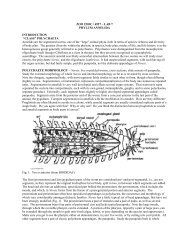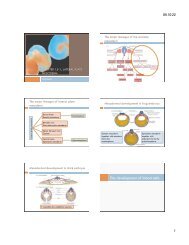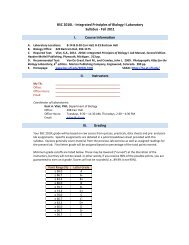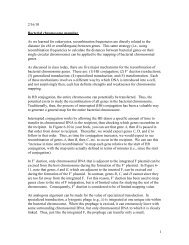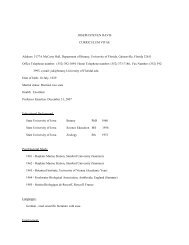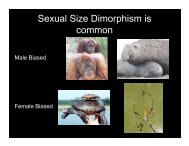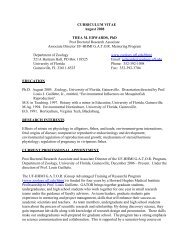Soil Respiration and Belowground Carbon ... - Biology Major
Soil Respiration and Belowground Carbon ... - Biology Major
Soil Respiration and Belowground Carbon ... - Biology Major
You also want an ePaper? Increase the reach of your titles
YUMPU automatically turns print PDFs into web optimized ePapers that Google loves.
<strong>Soil</strong> <strong>Respiration</strong> <strong>and</strong> <strong>Belowground</strong> <strong>Carbon</strong> Allocation 349CO 2 Effluxµmol m -2 s -16543210-1WaikopuaWhangapouaSitePortDouglasIntact microbial matRemoved microbial matHinchinbrookFigure 4. Mean soil respiration in dwarf mangrove forestswith an intact surface microbial community (blackbars) <strong>and</strong> where the microbial community had been removed(grey bars) (N = 6–8). Removing the surfacemicrobial community had a significant effect on soilrespiration: F 1,3 = 409.4, P = 0.0003.Total <strong>Belowground</strong> <strong>Carbon</strong> Allocationg C m -2 y -114001200100080060040020000 100 200 300 400 500Litterfallg C m -2 y -1Figure 6. Relationship between total belowground carbonallocation <strong>and</strong> litterfall over seven mangrove sites.There was no significant correlation. Sites include dwarfforests (
350 C. E. Lovelock<strong>Soil</strong> respiration was significantly correlated withLAI over all sites but the data were highly variable(Figure 2). Only a small portion of this variabilitycould be attributed to variations in soil temperature(Figure 3). LAI is an indicator of abovegroundbiomass, which is often closely correlated tobelowground biomass (Cannell <strong>and</strong> Dewer 1994).The highly variable relationship between LAI <strong>and</strong>soil respiration observed over our study sites couldreflect wide variation in allocation to fine roots(Ruess <strong>and</strong> others 2003), or variation in the heterotrophiccomponent of respiration both within<strong>and</strong> between sites (Bond-Lamberty <strong>and</strong> others2004). Both of these factors may be stronglyinfluenced by nutrient availability <strong>and</strong> redox ofsoils, which may vary widely within <strong>and</strong> amongmangrove forest ecosystems (Alongi <strong>and</strong> others2000, 2001, 2005a, b; Feller <strong>and</strong> others 2002;Lovelock <strong>and</strong> others 2007a, b). Errors in the gapfraction method used to estimate LAI over forests ofdiffering structure may also contribute (Bréda2003). As LAI can often be measured remotely (forexample, Green <strong>and</strong> others 1998), the relationshipbetween LAI <strong>and</strong> respiration may be a useful tool inestimating soil respiration over large spatial scales.Across the sites mangrove forest soil respirationwas correlated with litterfall (Figure 5) as has beenobserved in terrestrial forests (Raich <strong>and</strong> Nadelhoffer1989; Davidson <strong>and</strong> others 2002). The slope ofthe mangrove soil respiration versus litterfall relationshipwas lower than that observed for terrestrialforests (1.00 compared to the terrestrial forestslope of 2.92, Raich <strong>and</strong> Nadelhoffer 1989). Thislower sensitivity (shallower slope) of mangrove soilrespiration to increasing ANPP is linked to higherTBCA per ANPP in low productivity, low staturemangrove forests, <strong>and</strong> possibly to lower TBCA intaller stature forests with higher ANPP (Figure 6).Fundamental differences in the environment forroots between wetl<strong>and</strong> <strong>and</strong> terrestrial forest soilsthat are linked to tidal inundation, for example,wetl<strong>and</strong>s have highly variable redox states <strong>and</strong>nutrient availability, may contribute to the differencesobserved between mangroves <strong>and</strong> terrestrialforests in their TBCA over gradients in ANPP. Datafrom more productive forests than those includedin this study, for example, in Asia (for example,Alongi <strong>and</strong> others 2004), <strong>and</strong> Central America (forexample, Golley <strong>and</strong> others 1975), would beneeded to confirm a trend of lower TBCA in tallermangroves compared to terrestrial forests.The high TBCA estimated in dwarf forests comparedto taller forests may be linked to investmentof C belowground needed to withst<strong>and</strong> adverseenvironmental conditions, particularly anaerobicconditions <strong>and</strong> low nutrient availability, which arecommon in dwarf or scrub forests (Alongi <strong>and</strong>others 2000, 2001, 2005a, b; Feller <strong>and</strong> others2002, 2003; Lovelock <strong>and</strong> others 2004, 2007a, b.Relatively high rates of soil respiration <strong>and</strong> TBCA indwarf forests compared to taller forests are unlikelyto be due to respiration of live roots as live rootdensities, root growth rates <strong>and</strong> root respirationrates are low in dwarf mangrove forests (McKee2001; Lovelock <strong>and</strong> others 2006; McKee <strong>and</strong> others2007), but could be due to high rates of C exudatationfrom roots <strong>and</strong> high levels of heterotrophicrespiration (for example, Vazquez <strong>and</strong> others2000).Higher proportional TBCA in dwarf mangrovescompared to terrestrial forests could also be due tomineralization of C from other, non-mangrove treesources, which would introduce errors when usingthe carbon balance model. Detrital inputs fromadjacent seagrass <strong>and</strong> macroalgal beds, or from themicrophytobenthic community <strong>and</strong> from deliveryof sediments could enhance soil respiration <strong>and</strong>estimated TBCA. Delivery of sediments <strong>and</strong> detritusis lower in l<strong>and</strong>ward dwarf forests compared toseaward fringing mangrove st<strong>and</strong>s (Furukawa <strong>and</strong>others 1997) making additional inputs from outsidethe mangrove a small source of error in the modelfor dwarf forests. In contrast in situ production bymicrobial mats can be substantial (for example, Lee<strong>and</strong> Joye 2006) <strong>and</strong> may contribute to the highTBCA in dwarf compared to taller fringing forests.Problems with the carbon balance model’sassumption of steady state conditions have beendiscussed in detail by Davidson <strong>and</strong> others (2002).<strong>Carbon</strong> imports <strong>and</strong> exports in tidal dominatedecosystems like mangroves are likely to give rise toerrors in estimation of TBCA using the carbonbalance method (Figure 6). Estimation of TBCAthat included export of 10–50% of litterfall increasedTBCA, but did not change the overall patternsevident in the data. More thoroughassessment of C export is needed, particularly ofdissolved organic C (Twilley <strong>and</strong> others 1992;Dittmar <strong>and</strong> others 2006). Errors associated withdirect methods of estimating C allocation belowground are also very large (for example, Komiyama<strong>and</strong> others 1987; Robertson <strong>and</strong> Dixon 1993). Thetechnical difficulties of making direct measurementsof carbon allocation belowground in mangrovesoils <strong>and</strong> the need to assess TBCA for carbonbudgets over a wide range of representative forestsmake a first pass assessment using the carbon balancemethod useful, despite the potential flaws. Aspatially detailed underst<strong>and</strong>ing of C imports <strong>and</strong>exports from mangrove soils would greatly improve
<strong>Soil</strong> <strong>Respiration</strong> <strong>and</strong> <strong>Belowground</strong> <strong>Carbon</strong> Allocation 351the confidence in using carbon balance models, aswould longer term measurements of soil respirationthat encompassed variation with tidal cycles<strong>and</strong> over seasons.Influence of Temperature on <strong>Soil</strong><strong>Respiration</strong>Some of the variation in soil respiration over sitescould be explained by variation in soil temperature(Figure 3). Temperature responses of intact mangrovesoil respiration between 16° <strong>and</strong> 26°C (on theupward slope of the curve in Figure 3) was onaverage 2.6, close to the median Q 10 measured over arange of terrestrial vegetation types <strong>and</strong> sites (Raich<strong>and</strong> Schelsinger 1994; Boone <strong>and</strong> others 1998) <strong>and</strong>that predicted by Lloyd <strong>and</strong> Taylor (1994) indicatingthat mangrove soil respiration is not less sensitive totemperature as might be surmised from their tropical<strong>and</strong> subtropical distribution. The high variability inFigure 3 also indicates that Q 10 is variable. Q 10 hasbeen observed to vary seasonally, due to variation intemperature, water content of soils <strong>and</strong> also withphenology (for example, Xu <strong>and</strong> Qi 2001; Janssens<strong>and</strong> Pilkegaard 2003; Curiel Yuste <strong>and</strong> others 2004).Additionally, soil respiration did not increased withtemperature over the whole temperature range butshowed a decline at higher temperatures (Figure 3).Across the sites, higher temperatures in mangrovesoils were often associated with sparse canopies ofdwarf forests, where greater levels of direct sunlightpenetrate through mangrove canopies illuminating<strong>and</strong> warming the soil surface. High light levels at thesoil surface stimulate growth of microbial communities,which are comprised of cyanobacteria, diatoms,<strong>and</strong> other microalgae (Potts 1979; Joye <strong>and</strong>Lee 2004; Underwood <strong>and</strong> others 2005). Thesecommunities are capable of high rates of carbonfixation (Schories <strong>and</strong> Muhlig 2000; Lee <strong>and</strong> Joye2006). Experimental removal of the surface biofilmin New Zeal<strong>and</strong> <strong>and</strong> the cyanobacterial mat in NorthQueensl<strong>and</strong> sites (Port Douglas <strong>and</strong> HinchinbrookChannel) confirmed that photosynthetic organismson soil surfaces significantly decreased the efflux ofrespired C from deeper in the soil (Figure 4). Flux ofCO 2 into mangrove soils has been previously observed,along with increases in respiration with soildepth (Alongi <strong>and</strong> others 2001).Mangroves are highly efficient at conservingnutrients within individual trees (Feller 1995; Feller<strong>and</strong> others 2003; Alongi <strong>and</strong> others 2005a, b;Lovelock <strong>and</strong> others 2007a, b, <strong>and</strong> also at the ecosystemlevel (Alongi <strong>and</strong> others 1992). The resultspresented here suggest that in additional to efficientnutrient conservation, C losses from soils are alsolow in mangrove ecosystems, <strong>and</strong> are influenced bythe activity of photosynthetic microbial communities,particularly in dwarf forests. They also suggestthat the effects of global warming on soil respirationin mangrove forests is likely to be complex,depending not only on the effects of increases intemperature on photosynthesis, root respiration<strong>and</strong> the activity of bacterial communities, but alsoon the temperature response of benthic photosyntheticmicroorganisms. Additional interactions arelikely with other factors that influence mangrovecanopy development <strong>and</strong> thus light levels reachingthe soil surface, including sea level rise (Ellison <strong>and</strong>Farnsworth 1996), levels of nutrient enrichment(Lovelock <strong>and</strong> others 2006), <strong>and</strong> storm damage(Cahoon <strong>and</strong> others 2003) <strong>and</strong> underscore theimportance of underst<strong>and</strong>ing the roles of benthicmicrobial communities in carbon <strong>and</strong> nutrient cyclingin estuaries (An <strong>and</strong> Joye 2001) <strong>and</strong> otherecosystems with photosynthetic microbial crusts(for example, Cable <strong>and</strong> Huxman 2004).ConclusionsMangroves have similar rates of soil respiration asterrestrial forests, but they may achieve this atlower ANPP, giving support to the hypothesis thatmangrove forests allocate more carbon belowgroundthan do terrestrial forests. This was particularlyevident in dwarf forests which can beextensive (Lugo 1997). Over all sites, soil respirationcorrelated with LAI <strong>and</strong> litterfall, which mayprovide tools to scale up CO 2 flux from mangroveecosystems from currently available data sets. Theresponse of mangrove soil respiration to increasingtemperature was similar to that of terrestrial forestedecosystems, with a Q 10 of approximately 2.6for the lower temperature range (to 26°C). Athigher soil temperature, often in dwarf forests, soilrespiration declined with increasing temperaturedue to the activity of benthic photosyntheticmicrobial communities which are important inretaining respired C within the ecosystem.ACKNOWLEDGMENTSThis study was supported by the National ScienceFoundation under Grant DEB 99–81309, a WISCaward from the American Association for theAdvancement of Science, the New Zeal<strong>and</strong> Foundationfor Research, Science <strong>and</strong> Technology(C01X0024, C01X0215, <strong>and</strong> C01X0307), the HunterdonOceanographic Research Fund, the Smithsonian‘sMarine Science Network, the SmithsonianMarine Station at Fort Pierce, the Caribbean CoralReef Ecosystems Program (contribution no: 818)
352 C. E. Lovelock<strong>and</strong> Australian Research Council awards LP0561498<strong>and</strong> DP0774491. I thank C<strong>and</strong>y Feller, Roger Ruess,<strong>and</strong> Marilyn Ball, <strong>and</strong> the staff of Carrie Bow CayResearch Station <strong>and</strong> Pelican Beach Resort, Belize.Thanks also to Gary Raulerson who provided accessto unpublished data. Thanks are also extended tomany people who helped in the field, includingFern<strong>and</strong>a Adame, Dianne Allen, Don Cahoon, AnneChamberlain, Beth Clegg, Bettina Engelbrecht,Sharon Ewe, Ray Feller, Jane Halliday, Nicole Hancock,Helen Penrose, Brian Sorrell, Ann MareeSchwarz, <strong>and</strong> Rachel Tenni.REFERENCESAlongi DM. 2002. Present state <strong>and</strong> future of the world‘s mangroveforests. Environ Conserv 29:331–49.Alongi DM, Boto KG, Robertson AI. 1992. Foodchains <strong>and</strong> carbonfluxes. In: Roberston AI, Alongi DM, Eds. Tropical mangroveecosystems. Coastal <strong>and</strong> Estuarine Studies 41. Washington DC,USA: American Geophysical Union. pp 251–92.Alongi DM, Clough BF, Dixon P, Terendi F. 2003. Nutrientpartitioning <strong>and</strong> storage in arid-zone forests of the mangroveRhizophora stylosa <strong>and</strong> Avicennia marina. Trees 17:51–60.Alongi DM, Clough BF, Robertson AI. 2005. Nutrient-use efficiencyin arid-zone forests of the mangroves Rhizophora stylosa<strong>and</strong> Avicennia marina. Aquat Bot 82:121–31.Alongi DM, Pfitzner J, Trott LA, Tirendi F, Dixon P, Klumpp DW.2005. Rapid soil accumulation <strong>and</strong> microbial mineralization inforests of the mangrove K<strong>and</strong>elia c<strong>and</strong>el in the Jiulongjiangestuary, China. Estuar Coast Shelf Sci 63:605–18.Alongi DM, Sasekumar A, Chong VC, Pfitzner J, Trott LA, TerendiF, Dixon P, Brunskill GJ. 2004. <strong>Soil</strong> accumulation <strong>and</strong>organic material flux in a managed mangrove ecosystem:estimates of l<strong>and</strong>-ocean-atmosphere exchange in peninsularMalaysia. Mar Geol 208:383–402.Alongi DM, Tirendi F, Clough BF. 2000. Below-ground decompositionof organic matter in forests of the mangroves Rhizophorasylosa <strong>and</strong> Avicennia marina along the arid coast ofWestern Australia. Aquat Bot 68:97–122.Alongi DM, Wattayakorn G, Pfitzner J, Terendi F, Zagorskis I,Brunskill GJ, Davidson A, Clough BF. 2001. Organic carbonaccumulation <strong>and</strong> metabolic pathways in soils of mangroveforests in southern Thail<strong>and</strong>. Mar Geol 179:85–103.Amador JA, Jones RD. 1993. Nutrient limitation on microbialrespiration in peat soils with different total phosphorus content.<strong>Soil</strong> Bio Biochem 25:793–801.An S, Joye SB. 2001. Enhancement of coupled denitrification bybenthic photosynthesis in shallow subtidal estuarine soils.Limnol Oceanogr 46:62–74.Arreola-Lizarraga JA, Flores-Verdugo FJ, Ortega-Rubio A. 2004.Structure <strong>and</strong> litterfall of an arid mangrove st<strong>and</strong> on the Gulfof California, Mexico. Aqua Bot 79:137–43.Bond-Lamberty B, Wang C, Gower S. 2004. A global relationshipbetween the heterotrophic <strong>and</strong> autotrophic components ofsoil respiration?. Glob Change Biol 10:1756–66.Boone RD, Nadelhoffer KJ, Canary JD, Kaye JP. 1998. Rootsexert a strong influence on the temperature sensitivity of soilrespiration. Nature 396:570–72.Bréda NJJ. 2003. Ground-based measurements of leaf area index:a review of methods, instruments <strong>and</strong> current controversies.J Exp Bot 54:2403–17.Brouwer R. 1962. Distribution of dry matter in the plant. Neth JAgric Sci 10:399–408.Bunt JS. 1995. Continental scale patterns in mangrove litter fall.Hydrobiologia 295:135–40.Cable JM, Huxman TE. 2004. Precipitation pulse size effects onSonoran Desert soil microbial crusts. Oecologia 141:317–24.Cahoon DR, Hensel P, Rybczyk J, McKee K, Proffitt CE, Perez B.2003. Mass tree mortality leads to mangrove peat collapse atBay Isl<strong>and</strong>s, Honduras after Hurricane Mitch. J Ecol 91:1093–105.Cannell MGR, Dewar RC. 1994. <strong>Carbon</strong> allocation in trees—areview of concepts for modeling. Adv Ecol Res 25:59–104.Chapin FS. 1991. Effects of multiple environmental stresses onnutrient availability <strong>and</strong> use. In: Mooney HA, Winner W, PellEJ, Eds. Responses of plants to multiple stresses. PhysiologicalEcology Series. San Diego: Academic Press Inc. pp 67–88.Chimner RA. 2004. <strong>Soil</strong> respiration rates of tropical peatl<strong>and</strong>s inMicronesia <strong>and</strong> Hawaii. Wetl<strong>and</strong>s 24:51–56.Chmura GL, Anisfeld SC, Cahoon DR, Lynch JC. 2003. Globalcarbon sequestration in tidal, saline wetl<strong>and</strong> soils. Glob BiogeochemCycl 17:1111–20.Clough BF. 1998. Mangrove forest productivity <strong>and</strong> biomassaccumulation in Hinchinbrook Channel, Australia. Mangr SaltMarsh 2:191–8.Clough BF. 1992. Primary productivity <strong>and</strong> growth of mangroveforests. In: Roberston AI, Alongi DM, Eds. Tropical mangroveecosystems. Coastal <strong>and</strong> Estuarine Studies 41. WashingtonDC, USA: American Geophysical Union. pp 225–50.Curiel Yuste J, Janssens IA, Carrara A, Ceulemans R. 2004.Annual Q 10 of soil respiration reflects plant phonologicalpatterns as well as temperature sensitivity. Glob Change Biol10:161–9.Davidson EA, Savage K, Bolstad P, Clark DA, Curtis PS, EllsworthDS, Hanson PJ, Lay BE, Luo Y, Pregitzer KS, R<strong>and</strong>olfJC, Zak D. 2002. <strong>Belowground</strong> carbon allocation in forestsestimated from litterfall <strong>and</strong> IRGA-based soil respirationmeasurements. Agric Forest Meteorol 113:39–51.Davidson EA, Verchot LV, Cattanio HJ, Ackerman IL, CarvalhoJEM. 2000. Effects of soil water content on soil respiration inforests <strong>and</strong> cattle pastures of eastern Amazonia. Biogeochemistry48:53–69.Davie JDS. 1984. Structural variation, litter production <strong>and</strong>nutrient status of mangrove vegetation in Moreton Bay. In:Coleman RJ, Covacevich J, Darle P, Eds. Focus on Stradbroke.Brisbane: Boolarong Publications. pp 208–23.Dittmar T, Hertkorn N, Kattner G, Lara RJ. 2006. Mangroves, amajor source of dissolved organic carbon to the oceans. GlobBiogeochem Cycl 20:1–7.Duke N, Ball MC, Ellison JC. 1998. Factors influencing thediversity <strong>and</strong> distributional gradients in mangroves. Glob EcolBiogeogr Lett 7:27–47.Ellis J, Nicholls P, Craggs R, Hofstra D, Hewitt J. 2004. Effects ofterrigenous sedimentation on mangrove physiology <strong>and</strong>associated macrobenthic communities. Mar Ecol Progr Ser270:71–82.Ellison AM, Farnsworth EJ. 1996. Spatial <strong>and</strong> temporal variabilityin growth of Rhizophora mangle saplings on coral cays:links with variation in insolation, herbivory, <strong>and</strong> local sedimentationrate. J Ecol 84:717–31.
<strong>Soil</strong> <strong>Respiration</strong> <strong>and</strong> <strong>Belowground</strong> <strong>Carbon</strong> Allocation 353Ewel KC, Twilley RR, Ong JE. 1998. Different kinds of mangroveforests provide different goods <strong>and</strong> services. Glob Ecol BiogeogrLett 7:83–94.Fang C, Moncrieff JB. 2001. The dependence of soil CO2 effluxon temperature. <strong>Soil</strong> Biol Biochem 33:155–65.Feller IC. 1995. Effects of nutrient enrichment on growth <strong>and</strong>herbivory of dwarf red mangrove (Rhizophora mangle). EcolMonogr 65:477–505.Feller IC, Whigham DF, McKee KL, Lovelock CE. 2003. Nitrogenlimitation of growth <strong>and</strong> nutrient dynamics in a mangroveforest, Indian River Lagoon, Florida. Oecologia 134:405–14.Feller IC, Whigham DF, McKee KL, O‘Neill JP. 2002. Nitrogenvs. Biogeochemistry 62:145–75.Furukawa K, Wolanski E, Mueller H. 1997. Currents <strong>and</strong> sedimenttransport in mangrove forests. Estuar Coast Shelf Sci44:301–9.Giardina CP, Ryan MG. 2000. Evidence that decomposition ratesof organic carbon in mineral soil does not vary with temperature.Nature 404:858–61.Giardina CP, Ryan MG. 2002. <strong>Soil</strong> surface CO 2 efflux, litterfall<strong>and</strong> total belowground carbon allocation in a fast growingEucalyptus plantation. Ecosystems 5:487–99.Giardina CP, Ryan MG, Binkley D, Fownes JH. 2003. Primaryproduction <strong>and</strong> carbon allocation in relation to nutrient supplyin a tropical experimental forest. Glob Change Biol9:1438–50.Golley FB, McGinnis JT, Clements RT, Child G1, Duever MJ.1975. Mineral cycling in a tropical moist forest ecosystem.Athens: University of Georgia Press.Grace J, Rayment M. 2000. <strong>Respiration</strong> in the balance. Nature404:819–20.Green EP, Clark CD, Mumby PJ, Edwards AJ, Ellis AC. 1998.Remote sensing techniques for mangrove mapping. Int J RemoteSens 19:935–56.Guzman HM, Barnes PAG, Lovelock CE, Feller IC. 2005. A sitedescription of the CARICOMP mangrove, seagrass <strong>and</strong> coralreef sites in Bocas del Toro, Panama. Caribb J Sci 41:430–40.Högberg P, Nordgren A, Buchmann N, Taylor AFS, Ekblad A,Hogberg M, Nyberg G, Ottosson-Lofvenius M, Read DJ. 2001.Large-scale forest girdling shows that current photosynthesisdrives soil respiration. Nature 411:789–90.Howes BL, Dacey JWH, Teal JM. 1985. Annual carbon mineralization<strong>and</strong> belowground production of Spartina alternijlorain a New Engl<strong>and</strong> salt marsh. Ecology 66:595–605.Hutchings P, Saenger P. 1987. Ecology of mangroves. St Lucia,Brisbane, Australia: University of Queensl<strong>and</strong> Press.Janssens IA, Pilkegaard K. 2003. Large seasonal changes in Q 10 ofsoil respiration in a beech forest. Glob Change Biol 9:911–8.Jianwu Tang, Baldocchi DD, Liukang Xu. 2005. Tree photosynthesismodulates soil respiration on a diurnal time scale.Glob Change Biol 11:1298–304.Joye SB, Lee RY. 2004. Benthic microbial mats: importantsources of fixed nitrogen <strong>and</strong> carbon to the Twin Cays, Belizeecosystem. Atoll Res Bull 528:1–24.Komiyama A, Ogina K, Aksornkoae S, Sabhasri S. 1987. Rootbiomass of a mangrove forest in southern Thail<strong>and</strong>. 1. Estimationby the trench method <strong>and</strong> the zonal structure of rootbiomass. J Trop Ecol 3:97–108.Kuzyokov Y. 2002. Separating microbial respiration of exudatesfrom root respiration in non-sterile soils: a comparison of fourmethods. <strong>Soil</strong> Biol Biochem 34:1621–31.Lee RY, Joye SB. 2006. Patterns <strong>and</strong> controls on nitrogen fixation<strong>and</strong> denitrification in intertidal soils of a tropical oceanicmangrove isl<strong>and</strong>. Mar Ecol Prog Ser 307:127–41.Lloyd J, Taylor JA. 1994. On the temperature dependence of soilrespiration. Funct Ecol 8:315–23.Lovelock CE, Feller IC, Ball MC, Ellis J, Sorrell B. 2007. Testingthe Growth Rate vs. Geochemical Hypothesis for latitudinalvariation in plant nutrients. Ecol Lett 10:1154–63.Lovelock CE, Feller IC, Ellis J, Schwarz AM, Hancock N, NicholsP, Sorrell B. 2007. Mangrove growth in New Zeal<strong>and</strong> estuaries:the role of nutrient enrichment at sites with contrastingrates of sedimentation. Oecologia 153:633–41.Lovelock CE, Feller IC, McKee KL, Engelbrecht BM, Ball MC.2004. The effect of nutrient enrichment on growth, photosynthesis<strong>and</strong> hydraulic conductance of dwarf mangroves inPanama. Funct Ecol 18:25–33.Lovelock CE, Feller IC, McKee KL, Thompson R. 2005. Variationin mangrove forest structure <strong>and</strong> soil characteristics in Bocasdel Toro, Republic of Panamá. Caribb J Sci 41:456–64.Lovelock CE, Ruess RW, Feller IC. 2006. Fine root respiration inthe mangrove Rhizophora mangle over variation in forest stature<strong>and</strong> nutrient availability. Tree Physiol 26:1601–6.Lugo AE. 1997. Old-growth mangrove forests in the UnitedStates. Conserv Biol 11:11–20.Lugo AE, Snedaker SC. 1974. The ecology of mangroves. AnnRev Ecol System 5:39–64.Macintyre IG, Littler MM, Littler DS. 1995. Holocene history ofTobacco Range, Belize, Central America. Atoll Res Bull 43:1–18.Manson FJ, Loneraganc NR, Phinn SR. 2003. Spatial <strong>and</strong> temporalvariation in distribution of mangroves in Moreton Bay,subtropical Australia: a comparison of pattern metrics <strong>and</strong>change detection analyses based on aerial photographs. EstuarCoast Shelf Sci 57:653–66.McKee KL. 1996. Growth <strong>and</strong> physiological responses of neotropicalmangrove seedlings to root zone hypoxia. TreePhysiol 16:883–9.McKee KL. 2001. Root proliferation in decaying roots <strong>and</strong> oldroot channels: a nutrient conservation mechanism in oligotrophicmangrove forests?. J Ecol 89:876–87.McKee KL, Cahoon DR, Feller IC. 2007. Caribbean mangrovesadjust to rising sea level through biotic controls on change insoil elevation. Glob Ecol Biogeogr 16:545–56.McKee KL, Faulkner PL. 2000. Mangrove peat analysis <strong>and</strong>reconstruction of vegetation history at the Pelican Cays, Belize.Atoll Res Bull 48:46–58.McKee KL, Feller IC, Popp M, Wanek W. 2002. Mangrove isotopicfractionation (d 15 N <strong>and</strong> d 13 C) across a nitrogen versusphosphorus limitation gradient. Ecology 83:1065–75.Melillo JM, Steudler PA, Aber JD, Newkirk K, Lux H, Bowles FP,Catricala C, Magill A, Ahrens T, Morrisseau S. 2002. <strong>Soil</strong>warming <strong>and</strong> carbon-cycle feedbacks to the climate system.Science 298:2173–217.Middleburg JJ, Nieuwenhuize J, Slim FJ, Ohowa B. 1996. Sedimentbiogeochemistry in an East African mangrove forest(Gazi Bay, Kenya). Biogeochem 34:133–55.Potts M. 1979. Nitrogen fixation (acetelene reduction) associatedwith communities of heterocystous <strong>and</strong> nonheterocystousbluegreen algae in mangrove forests of Sinai. Oecologia39:359–73.Raich JW. 1998. Aboveground productivity <strong>and</strong> soil respirationin three Hawaiian rain forests. For Ecol Manage 107:309–18.
354 C. E. LovelockRaich JW, Nadelhoffer KJ. 1989. <strong>Belowground</strong> carbon allocationin forest ecosystems: global trends. Ecology 70:1346–54.Raich JW, Schlesinger WH. 1992. The global carbon dioxide fluxin soil respiration <strong>and</strong> its relationship to vegetation <strong>and</strong> climate.Tellus 44B:81–99.Raich JW, Tufekcioglu A. 2000. Vegetation <strong>and</strong> soil respiration:correlations <strong>and</strong> controls. Biogeochemistry 48:71–90.Robertson AI, Alongi DM, Boto KG. 1992. Foodchains <strong>and</strong> carbonfluxes. In: Roberston AI, Alongi DM, Eds. Tropical mangroveecosystems. Coastal <strong>and</strong> Estuarine Studies 41. Washington DC,USA: American Geophysical Union. pp 293–326.Robertson AI, Dixon P. 1993. Separating live <strong>and</strong> dead fine rootsusing colloidal silica: an example from mangrove forests. Plant<strong>Soil</strong> 157:151–4.Ruess RW, Hendrick RL, Burton AJ, Pregitzer KS, SveinbjornssonB, Allen MF, Maurer G. 2003. Coupling fine rootdynamics with ecosystem carbon cycling in black spruce forestsof interior Alaska. Ecol Monogr 74:643–62.Rustad LE, Thomas G, Huntington M, Boone RD. 2000. Controlson soil respiration: implications for climate change. Biogeochemistry48:1–6.Saenger P, Snedaker SC. 1993. Pantropical trends in mangroveabove-ground biomass <strong>and</strong> annual litterfall. Oecologia96:293–329.Schlesinger WH, Andrews JA. 2000. <strong>Soil</strong> respiration <strong>and</strong> theglobal carbon cycle. Biogeochemistry 48:7–20.Schories D, Muhlig U. 2000. CO 2 gas exchange of benthic mciroalgaeduring exposure to air: a technique for the rapidassessment of primary production. Wetl Ecol Manag 8:273–80.Schwarz AM. 2004. Contribution of photosynthetic gains duringtidal emersion to production of Zostera capricorni in a NorthIsl<strong>and</strong>, New Zeal<strong>and</strong> estuary. New Zeal J Mar Fresh Res38:809–18.Spalding MD, Balsco F, Field CD. 1997. World mangrove atlas.The International Society for Mangrove Ecosystems. Japan:Okinawa.Twilley RR. 1985. The exchange of organic carbon in basinmangrove forests in a southwest Florida estuary. Estuar CoaslShelf Sci 20:543–7.Twilley RR, Chen RH, Hargis T. 1992. <strong>Carbon</strong> sinks in mangroves<strong>and</strong> their implications to carbon budget of tropicalcoastal ecosystems. Water Air <strong>Soil</strong> Poll 64:265–88.Twilley RR, Lugo AE, Patterson-Zucca C. 1986. Litter production<strong>and</strong> turnover in basin mangrove forests in southwest Florida.Ecology 67:670–83.Underwood GJC, Perkins RG, Consalvey M, Hanlon ARM, OxboroughK, Paterson DM. 2005. Patterns in microphytobenthicprimary productivity: species-specific variation inmigratory rhythms <strong>and</strong> photosynthesis in mixed species biofilms.Limnol Oceanogr 50:755–76.Valentini R, Matteucchi G, Dolman H, Schulze E-D, Rebmann C,Moors EJ, Granier A, Gross P, Jensen NO, Pilgaard K, LindrothA, Grelle A, Bernhofer C, Grünwald T, Aubinet M, CeulemansR, Kowalski AS, Vesala T, Rannik ü, Berbigier P, Lousteau D,Gudmundsson J, Thorgairsson H, Ibrom A, Morgenstern K,Clement R, Moncrieff J, Montagnani L, Minerbi S, Jarvis PG.2000. <strong>Respiration</strong> as the main determinant of carbon balancein European forests. Nature 404:861–5.Valiela I, Bowen JL, York JK. 2001. Mangrove forests: one of theworld‘s threatened major tropical environments. BioScience51:807–81.Vazquez P, Holguin G, Puente ME, Lopez-Cortes A, Bashan Y.2000. Phosphate-solubilizing microorganisms associated withthe rhizosphere of mangroves in a semiarid coastal lagoon.Biol Fert <strong>Soil</strong>s 30:460–8.Xu M, Qi Y. 2001. Spatial <strong>and</strong> seasonal variations of Q 10 determinedby soil respiration measurements at a Sierra Nevadanforest. Glob Biogeochem Cycl 15:687–96.





